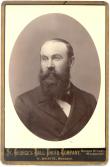One of the most well-known and successful scenic artists to work in Australia during the late 19th and early 20th centuries, Harry Whaite arrived in Australia from England at the end of 1884. He soon afterwards collaborated with John L. Hall on the scenery for Amy Horton Burlesque Co tour and within a year was employed as principal assistant to W. B. Spong for the newly formed Brough and Boucicault Comedy Company. After that partnership dissolved he continued to provide scenery for Robert Brough, and later with Brough and Fleming.
During the 1890s and early 1900s Whaite also provided scenery for producers such as Frank Smith (Alahambra, Syd), the MacMahon brothers (Lyceum, Syd), George Musgrove (Princess, Melb), Frank York and George A. Jones (Empire, Syd), Charles Holloway and William Anderson (Lyceum, Syd), and George Willoughby and Hugh J. Ward (Criterion, Syd). In 1909 Whaite established Metropolitan Scenic Studio in the inner-Sydney suburb of Paddington. In this venture he was assisted by his third wife, Daisy, an artist who specialised in figure subjects. By 1914 he had also taken on a partner, George Dixon, with the company known for a brief period as Whaite-Dixon.
Up until his death in 1931 Whaite provided scenic art for many of the leading theatre and vaudeville organisations operating in both Australia and New Zealand, including J.C. Williamson's, Hugh J. Ward, Alan Hamilton, John L. Goodman, James Brennan, Harry Rickards Tivoli Theatres, J.C. Bain and Harry Clay and Kate Howarde. He also worked with amateur companies such as the Mosman Musical Society (Syd), Petersham Choral Society (Syd) and the Brisbane Operatic Players, and even with governments - providing, for example, a drop scene for the Fijian Town Hall in 1910.
Whaite's son Frederick, became a well-known pianist, composer and conductor in both the theatre and radio.
[Source: Australian Variety Theatre Archive]
 3963389305001620689.jpg
3963389305001620689.jpg